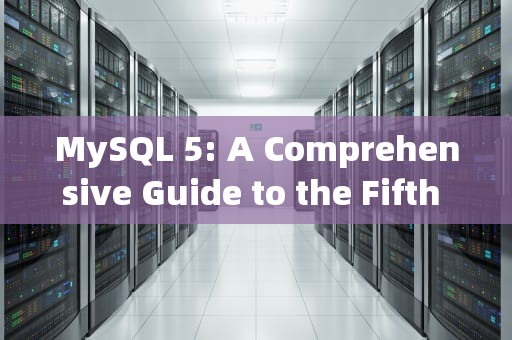Introduction

MySQL is an open-source relational database management system (RDBMS) that has become one of the most popular databases in the world. Since its initial release in 1995, MySQL has undergone numerous updates and improvements. One of the most significant milestones in its development history was the release of MySQL 5 in October 2005. This article aims to provide a comprehensive guide to MySQL 5, covering its features, benefits, and how it compares to other versions of MySQL.
What is MySQL 5?
MySQL 5, also known as MySQL 5.0, is the fifth major release of the MySQL database system. It introduced a plethora of new features and enhancements over its predecessor, MySQL 4.x. Some of the key improvements included better support for stored procedures, triggers, views, and foreign keys, which brought MySQL closer to compliance with the SQL:1999 standard. Additionally, MySQL 5 introduced several performance optimizations, improved security features, and better support for replication and clustering.
Key Features of MySQL 5
1、Stored Procedures and Functions: MySQL 5 introduced support for stored procedures and functions, allowing developers to write reusable code within the database itself. This feature greatly enhances the capabilities of MySQL, making it more suitable for complex applications.
2、Triggers: Triggers are events that activate specific actions when certain conditions are met. MySQL 5's support for triggers allows for more sophisticated data integrity checks and automated tasks.
3、Views: Views are virtual tables that can be used to present data from one or more tables in different ways. MySQL 5's support for views simplifies complex queries and enhances data abstraction.
4、Foreign Key Support: Foreign keys are used to enforce referential integrity between tables. MySQL 5's improved support for foreign keys ensures data consistency and accuracy across related tables.
5、Performance Enhancements: MySQL 5 includes several performance optimizations, such as query cache improvements, index enhancements, and better memory management. These enhancements result in faster query execution and overall improved database performance.
6、Security Features: MySQL 5 introduces several security enhancements, including better password hashing, SSL support for secure connections, and more granular access controls. These features help protect sensitive data and ensure secure database operations.
7、Replication and Clustering: MySQL 5 improves support for replication, allowing for more robust and efficient data synchronization between master and slave servers. Additionally, it introduces basic support for clustering, enabling high availability and load balancing.
8、XML Support: MySQL 5 includes built-in support for XML data, allowing for easier storage and manipulation of XML documents within the database.
9、Improved Administration Tools: MySQL 5 comes with enhanced administrative tools, such as the MySQL Workbench, which provides a user-friendly interface for managing and administering MySQL databases.
Benefits of Upgrading to MySQL 5
Upgrading to MySQL 5 offers several benefits, including:
Enhanced Functionality: The introduction of stored procedures, triggers, views, and foreign keys significantly expands the capabilities of MySQL, making it more versatile and powerful.
Improved Performance: The performance optimizations in MySQL 5 result in faster query execution and better overall database performance, which can lead to cost savings and improved user experience.
Better Security: The security enhancements in MySQL 5 help protect sensitive data and ensure secure database operations, reducing the risk of data breaches and unauthorized access.
Scalability: The improved support for replication and clustering in MySQL 5 enables better scalability, allowing organizations to handle larger workloads and achieve higher availability.
Ease of Use: The improved administration tools and user-friendly interface make it easier to manage and administer MySQL databases, reducing the learning curve and improving productivity.
How MySQL 5 Compares to Other Versions
While MySQL 5 represents a significant advancement over previous versions, it is essential to understand how it compares to other versions, particularly MySQL 8, the latest major release. Here are some key differences:
Data Types and Storage Engines: MySQL 8 introduces new data types and default storage engines, such as JSON and InnoDB, respectively. These enhancements provide better support for modern application requirements.
Transactional Support: MySQL 8 offers more robust transactional support, including the ability to rollback transactions and improved error handling. This makes it more suitable for applications that require high levels of data integrity.
Performance: MySQL 8 includes several performance improvements, such as the Optimizer Cost Model and the ability to use multiple CPU cores for query execution. These enhancements result in faster query performance and better overall database efficiency.
Security: MySQL 8 introduces several new security features, such as caching_sha2_password authentication plugin and role-based access control. These features provide better protection against security threats and simplify user management.
JSON Support: MySQL 8's native JSON support allows for easier storage and manipulation of JSON data, making it more suitable for applications that work with JSON formatted data.
Window Functions: MySQL 8 introduces window functions, which allow for more advanced data analysis and reporting capabilities.
Despite these advancements, MySQL 5 remains a popular choice for many organizations due to its stability, compatibility with existing systems, and extensive community support. However, for new projects or applications requiring the latest features and performance improvements, upgrading to MySQL 8 may be the better option.
Conclusion
MySQL 5 is a significant milestone in the development history of MySQL, introducing numerous new features and enhancements that have made it one of the most popular databases in the world. Its support for stored procedures, triggers, views, and foreign keys, along with its performance optimizations and security enhancements, make it a powerful and versatile database system. While newer versions like MySQL 8 offer additional features and improvements, MySQL 5 remains a reliable and widely used database solution for many organizations. Whether you are considering upgrading from an older version or choosing a database system for a new project, understanding the features and benefits of MySQL 5 can help you make an informed decision.
随着互联网的普及和信息技术的飞速发展台湾vps云服务器邮件,电子邮件已经成为企业和个人日常沟通的重要工具。然而,传统的邮件服务在安全性、稳定性和可扩展性方面存在一定的局限性。为台湾vps云服务器邮件了满足用户对高效、安全、稳定的邮件服务的需求,台湾VPS云服务器邮件服务应运而生。本文将对台湾VPS云服务器邮件服务进行详细介绍,分析其优势和应用案例,并为用户提供如何选择合适的台湾VPS云服务器邮件服务的参考建议。

工作时间:8:00-18:00
电子邮件
1968656499@qq.com
扫码二维码
获取最新动态
